Most Popular Brazilian Fruits
Brazil is a favorite destination for world travelers and is loved for its lush coastline, vibrant culture, and welcoming people. As the fifth largest country in the world land-wise, you’ll find plenty of diversity from landscapes right down to little things like fruits. In fact, there are estimated 300-plus varieties of fruits grown in Brazil. Many of them, like coconuts and mangoes, are common everywhere while others you likely never heard of.
The fruit exportation industry doesn’t find exporting these lesser-known fruits feasible, and most countries have strict rules against bringing them on planes due to the risk of spreading diseases and pests. So if your travels take you to Brazil, here are some must-try fruits to discover.
Passion Fruit
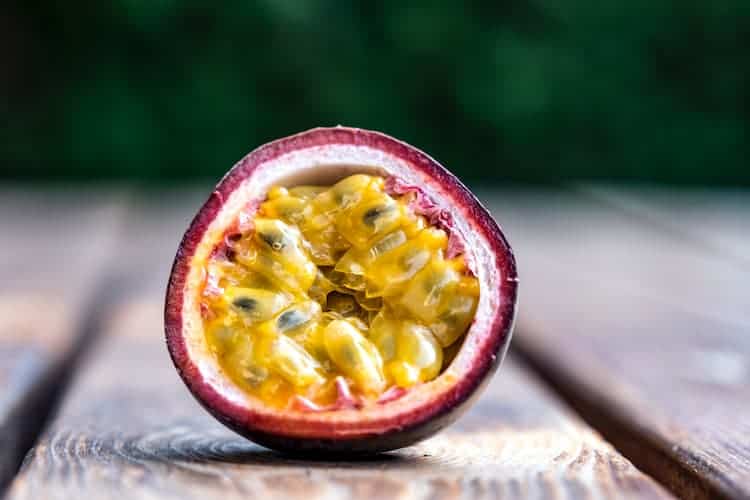
Also called Maracujá, passion fruit is a tiny fruit native to the Brazilian Amazon. The fruit contains more seeds than flesh, but both are edible and very tasty.
Passion fruit has earned a spot on the list of superfoods by nutritionists meaning it is high in disease-fighting antioxidants. It is also rich in anti-inflammatory properties and dietary fiber and contains a little iron. The fruit is crunchy and has somewhat of a sour taste.
Like strawberries in other countries, passion fruit is used in chocolate bars and toffees in Brazil, and you can find passion fruit ice cream made with both the flesh and the seeds.
Fresh passion fruit and passion fruit candies are easy to find in Brazil and can be bought at supermarkets and street vendors. The fresh passion fruit will look better and cost less during the Brazilian winter (June-August.)
Cashew Apple

Cashew apple probably has you thinking of the cashew nut that is common all across North America. But the cashew apple is practically unheard of on the continent to the north of Brazil. That’s because the fruit’s thin skin makes it very fragile and impossible to transport successfully.
Sometimes referred to as a “false fruit,” is actually rich in nutrients and helps with issues such as stomach ulcers, diarrhea, and gastritis. The juice is used to help relieve aches.
The cashew apple is orangish in color and pear-shaped with a sweet smell and taste. It’s a very juicy fruit and is used to make a refreshing, tropical beverage.
Although you may never have heard of cashew apples, you probably have come in contact with this fruit. It’s commonly used in shampoos and cosmetic creams.
Star Fruit

Known as carambola, this Brazilian fruit is easy to identify by its star shape giving it the more common English name of star fruit, and you will find it in American supermarkets as such. The plant is not native to Brazil but thrives in Brazil’s soil and climate, and many locals grow carambola plants in their backyards.
This Brazilian fruit’s pretty shape makes it more popular as a garnish than for eating. Its high levels of oxalic acid make it a danger to be consumed by people with kidney problems.
Buriti
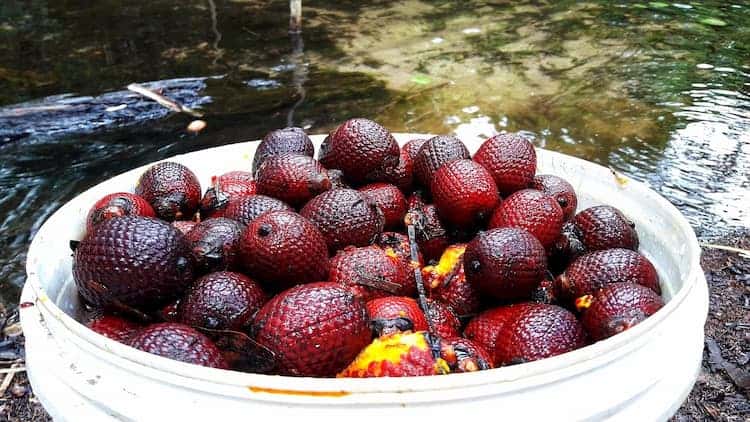
Often called the tree of like thanks to its myriad of health benefits, the Buriti is one of Brazil’s most popular fruit trees. The palm-like tree is abundant in Brazil as well as other South American countries such as Colombia, Ecuador, and Peru.
The nutlike fruit of the tree is easily confused with chestnuts because of the reddish-brown color and shiny scales. The fruit is harvested from December to June.
Buriti is eaten raw and is also used to make juice, jam, ice cream, fermented wine, and other snacks and desserts. It’s also a popular ingredient in cosmetic products. It has been proven to reduce lines and wrinkles and lighten dark spots from too much sun as well as relieve rashes and irritation.
Needless to say, Buriti is a common ingredient in Brazilian beauty products. Brazilian women are known for their beauty, so take some home.
Brazilian Cherry

The Brazilian Cherry or Pitanga fruit plant is popular as a hedge in Brazilian gardens and in other east coast South American countries such as Argentina and Paraguay where it is a native plant. Today, it’s considered to be an unwanted invasive species in some areas.
The fruit of the plant is a botanical berry that resembles a tiny pumpkin or tomato. In some parts of the world, its called a Surinam cherry or a cayenne cherry. When the fruit is green to orange, the taste is tart. When it turns red or black, the fruit is very sweet.
Rich in vitamins A and C, Brazilian cherries are used to flavor jams and jellies and in desserts like mousses and marmalades.
If you get to visit a local Brazilian’s home, you may find the leaves of the plant scattered across the floor. The scent is said to repel flies.
Sugar Apple
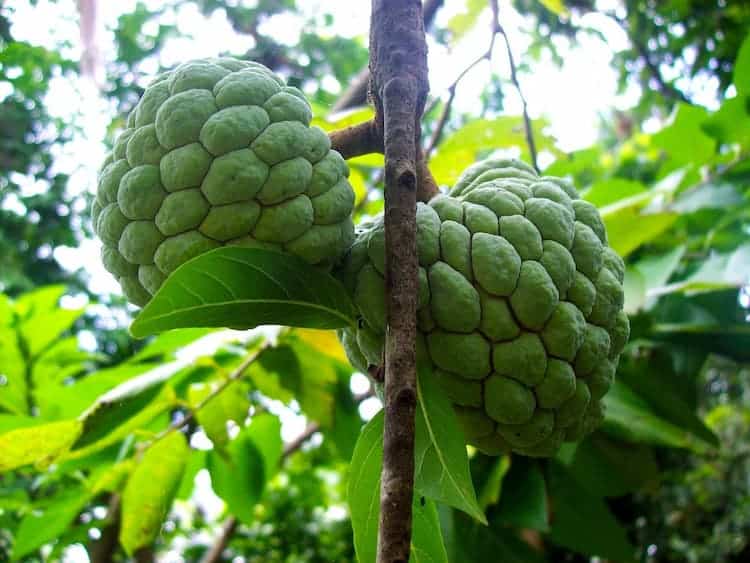
Also called custard apples, sugar apples were introduced to Brazil by a Portuguese Count in 1626. The Portuguese name for the green, cone-shaped fruit is fruta-do-conde meaning the “count’s fruit.” Sugar apples grow best in tropical high altitudes like the Andes.
Sugar apples have lots of seeds which some people don’t like, but the extra-sweet flavor is popular with others. The whitish flesh has a creamy custard-like consistency. They are soft when ripe and if they’re hard and like an avocado, you must wait until they turn soft to eat. This may take several days. Serve chilled and eat with a spoon.
As for health benefits, sugar apples are rich in vitamins, minerals, and fiber. They are known to reduce inflammation, support immunity, and promote heart and eye health.
Champagne Orange
Love sipping on mimosas? Then you’ll want to try the champagne orange while traveling in Brazil. It’s essentially the same taste without the side effects. Unfortunately, they’re most often found on private property, but if you get lucky, you may find some at the market or a street vendor. The good news is, they are much cheaper than that mimosa you had at brunch. One kilogram will only cost about 4-5 BRL (0.79-0.99 USD.)
Champagne oranges are the size of a large navel orange and are yellowish-green in color. The smell is a combination of lemon and vanilla, and the taste is like sweet champagne.
Açaí

Because of its extraordinary health benefits, açaí has become popular in many parts of the world, but in Brazil, you will find these berries absolutely everywhere. Shops and cafes are dedicated to the exotic fruit and sell everything from candy and chocolates to ice cream, smoothies, and pure pulp. You’ll even find t-shirts with “açaí” printed on them.
Açaí berries are higher in antioxidants than North American superfoods such as blueberries and cranberries. These antioxidants are thought to help prevent cancer. The berries also have high levels of fatty acids which is unusual for a fruit. These are the same substances found in cold-water fish that help control high cholesterol and high blood pressure.
Açaí isn’t liked by everyone though. The taste of them is somewhat bitter like dark chocolate.
Guaraná
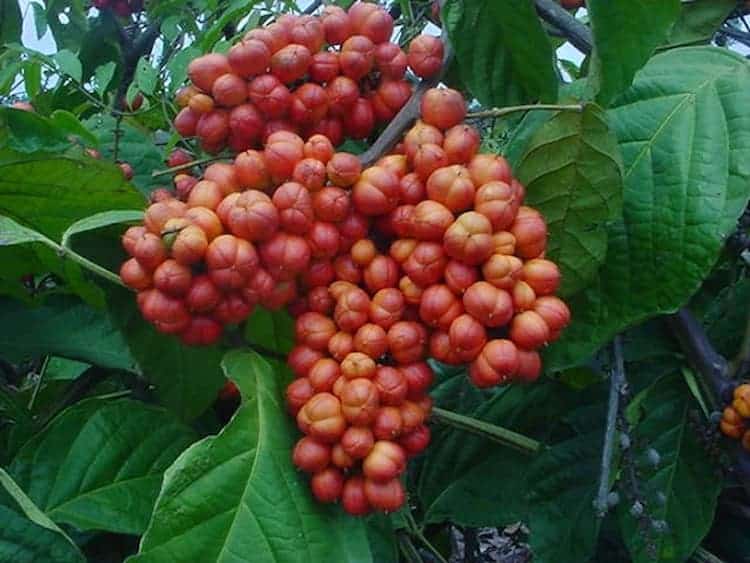
Image courtesy of Wikimedia
In Brazil, the guaraná fruit is better known as a soft drink than a fruit. In fact, Guaraná Antarctica is Brazil’s national soft drink. The popular Brazilian soda has used guaraná in its production since 1909. The fruit has overly sweet, white flesh with dark seeds.
The seeds of the guaraná fruit have double the amount of caffeine than coffee seeds. Before being discovered by the Europeans, Amazonian Indians used the fruit for its stimulating qualities. The seeds contain specific molecules that cause the caffeine in the fruit to be slowly released, providing the body with energy for longer. Since they speed up metabolism, guaraná is popular as an aid for weight loss.
Most Brazilians claim that the original version of Guaraná Antarctica was better than the newer one. It had a fruity taste, wasn’t too sweet, and had about the same stimulating properties as coffee.
Pineapple
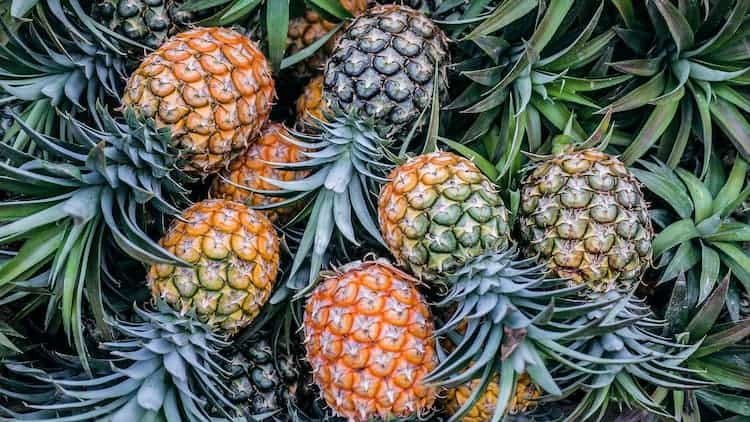
The whole world is familiar with pineapple from mom’s pineapple upside-down cake to pina coladas. But like everything else, the fresh fruit from its homeland tastes the best.
The tasty pineapple originates from southern Brazil and Paraguay near the Parana-Paraguay River. It has been grown and cultivated in the wild for centuries growing as a small shrub.
One delicious pineapple dessert to look for in Brazil is called pave de abacaxi e coco (pineapple and coconut pave.) It consists of pineapple chunks layered with ladyfinger cookies and covered with a concoction of rum, condensed milk, heavy cream, and vanilla extract with crushed cashews sprinkled on top. Yum!
Cupuaçu
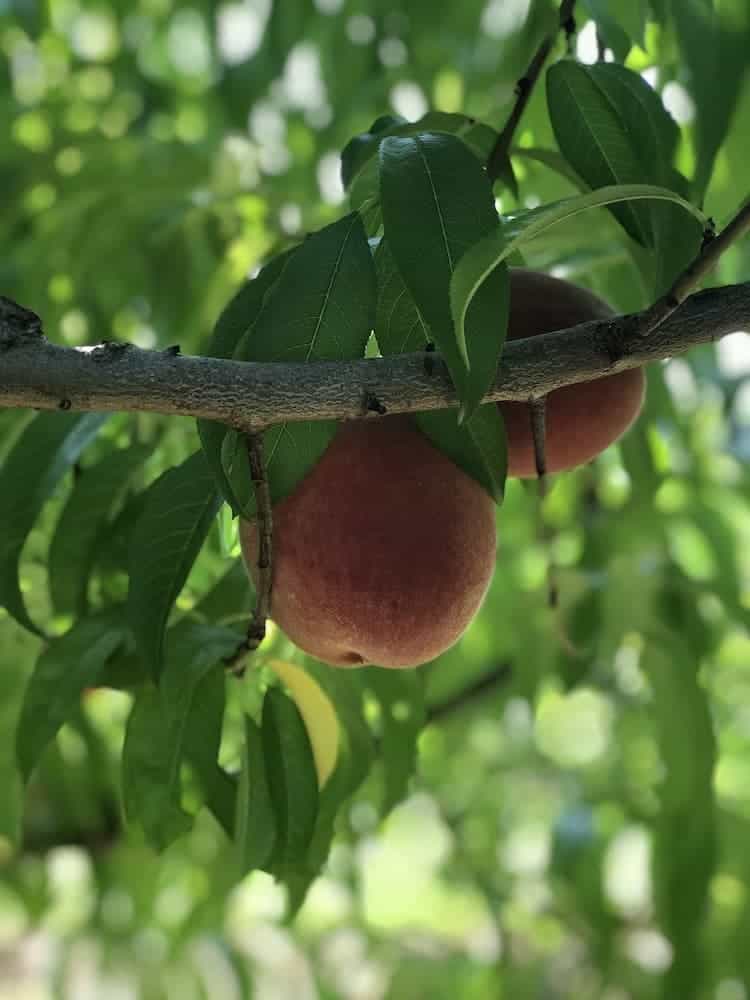
The capuaçu looks similar to a huge kiwi with white flesh and a seedpod in the center like an avocado. Just one weighs around one kilogram (2.2 lbs.) Its scent, as strange as its looks, is a cross between pineapple and chocolate. That may be because the capuaçu belongs to the same botanical family as the cocoa plant. The taste has a hint of citrus but is a little sweeter.
Like many other Brazilian fruits, it contains lots of antioxidants and vitamins. It’s a rare fruit and is only found in specialty markets. You may find frozen cupuaçu pulp sold alongside açaí.
Siriguela

Siriguela is an exotic fruit and is even unknown in some parts of Brazil. It’s native to northeastern Brazil where the small, round fruit is very popular. They are widely available in that area during siriguela season.
Yellowish in color, the siriguela is very juicy and looks like a tiny mango. They are eaten as a snack on their own, and the juice is used to flavor ice cream. Because they’re so small, the siriguela is eaten with the skin on.
Although this fruit hasn’t been widely researched, it has been established as a superfruit with high levels of antioxidants, vitamins, and minerals. They increase energy, reduce swelling, and strengthen the immune system.
Cambuci

Image courtesy of Wikimedia
This strange-looking fruit is grown in southeastern Brazil’s Atlantic forest where the Campomanesia phaea plant grows and bears the fruit. It’s shaped like a tiny alien spaceship and has a hint of yellow when it ripens between January and April.
The cambuci plant is grown locally in Rio de Janeiro, Parana, and Sao Paulo. One of Sao Paulo’s oldest neighborhoods is named after the fruit.
Cambuci isn’t normally eaten raw because its lemon-like flavor is very sour. It’s commonly used in Brazilian recipes for jams and sauces and added to cachaca liquor for use in Brazilian drinks.
Pitomba
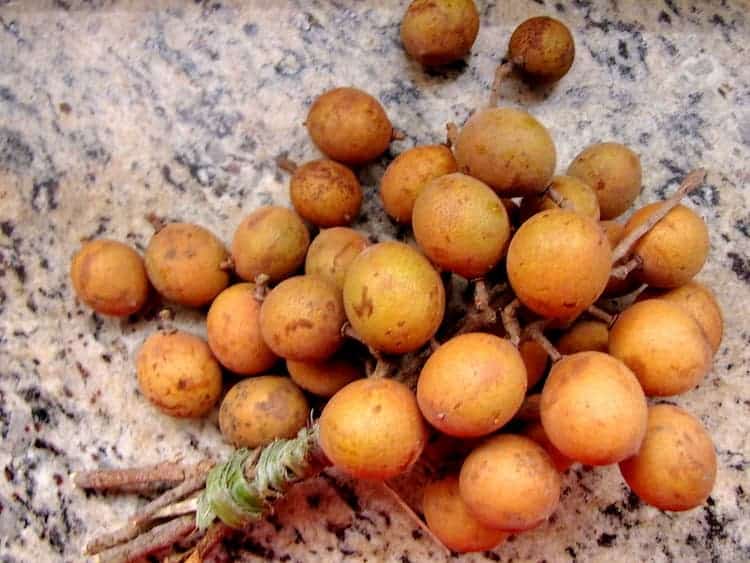
Image courtesy of Flickr
The pitomba fruit is yellow in color and looks like a tiny orange. The tree it grows on is native to the Amazon basin and grows prolifically in Brazil, Bolivia, Colombia, and Paraguay. The tree grows as high as 20 meters and produces clusters of fragrant white flowers.
The fruit inside the pitomba’s peel is white in color and almost translucent. It contains two elongated seeds. The flesh is sweet enough to be eaten raw, and the juices are used in several Brazilian food recipes. The seeds are roasted and used as an alternative treatment for diarrhea.
Jenipapo
The jenipapo is a small, unusual Brazilian fruit native to the Amazon forests. Classified as a berry, it grows as large as a melon. If one didn’t know better, they would think this strange fruit was rotten when ripe because of its brown color and dry texture.
The jenipapo smells and tastes as odd as it looks. It’s mostly used in recipes for compotes, syrups, and liqueurs. Recently, a bitter, blue version has piqued the interest of Brazilian chefs. They have used it to color different dishes including pasta and tortillas, or to give deserts like flans and crème anglaise their distinct blue color.
Which of these Brazilian fruits would you like to try? Let us know in the comments.
About the Author Anna Timbrook
Anna is the co-owner of expert world travel and can't wait to share her travel experience with the world. With over 54 countries under her belt she has a lot to write about! Including those insane encounters with black bears in Canada.

